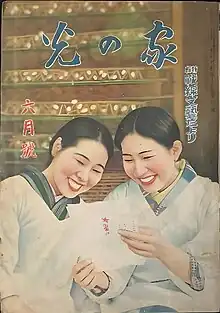 Cover of a 1939 edition | |
| Categories | Family magazine |
|---|---|
| Frequency | Monthly |
| Publisher | Ie no Hikari Association |
| Founded | 1925 |
| Country | Japan |
| Based in | Tokyo |
| Language | Japanese |
| Website | https://www.ienohikari.net/ |
| OCLC | 649014893 |
Ie no Hikari (Japanese: 家の光, romanized: ie no hikari, lit. 'Light in Home') is a monthly Japanese family magazine published in Tokyo, Japan. It is one of the oldest and best-selling magazines in the country. In addition, it is one of two most popular magazines in Japan during the mid-twentieth century, the other one being Kingu magazine.[1] Both are the first Japanese million-seller magazines.
History and profile
Ie no Hikari was established in 1925.[2][3] Shimura Gentarō and Arimoto Hideo, leaders of the Industrial Cooperative, were instrumental in the foundation of the magazine.[1] At the initial period the magazine was controlled by the ministry of agriculture and forestry,[3] and was published by the Industrial Cooperative. The magazine targets rural readers.[4] However, it has another version for urban readers.[5] It supports for agrarianism and features articles on home economics, children's stories and news.[3] During the 1930s it covered articles on Manchuria Crisis in parallel to the official views of the government.[3] In 1933 the magazine serialized a novel by Toyohiko Kagawa, Chichi to Mitsu no Nagaruru Sato (Japanese: A village where milk and honey flow).[6] It was about the implementation of cooperative insurance.[6]
The magazine is part of and published by Ie-No-Hikari Association, founded in 1944 as part of Central Industrial Union, which was later renamed as Central Union of Agricultural Cooperatives.[2] The magazine has its headquarters in Tokyo.[7][8]
Circulation
During the last half of 1931 the circulation of Ie no Hikari was 150,000 copies which reached more than 500,000 copies by December 1933.[3] In 1935 the magazine was read by a million people in the country.[3] It managed to keep this rate until 1944.[3]
In 1994 Ie no Hikari sold 983,736 copies.[9]
Ie no Hikari had a circulation of 586,572 copies in 2010 and of 582,983 copies in 2011.[10] In 2012 it was the sole Japanese magazine enjoyed circulation of half a million copies.[11] It was the sixth best-selling magazine in Japan between October 2014 and September 2015 with a circulation of 569,359 copies.[12]
Legacy
In 2019 Amy Bliss Marshall published a book named Magazines and the Making of Mass Culture in Japan in which she analysed Kingu and Ie no Hikari to demonstrate the birth of mass culture in Japan.[13] The author argues that these two magazines were instrumental in the establishment of mass culture and in the socialization in Japan.[13]
References
- 1 2 "Mass Culture in Interwar Japan". Dissertation Reviews. 11 February 2013. Retrieved 24 April 2016.
- 1 2 "Ie-No-Hikari Association". International Co-operative Alliance. Retrieved 24 April 2016.
- 1 2 3 4 5 6 7 Sandra Wilson (2003). The Manchurian Crisis and Japanese Society, 1931-33. London; New York: Routledge. p. 140. ISBN 978-1-134-53204-9.
- ↑ Sharalyn Orbaugh (2006). Japanese Fiction of the Allied Occupation: Vision, Embodiment, Identity. Leiden; Boston, MA: BRILL. p. 237. ISBN 978-90-474-1166-6.
- ↑ Miriam Rom Silverberg (2007). Erotic Grotesque (PDF). Berkeley and Los Angeles, CA: University of California Press, Ltd. ISBN 978-0-520-22273-1.
- 1 2 "Cooperative Insurance Business in Japan" (PDF). Japan Cooperative Insurance Association Incorporated. Archived from the original (PDF) on 8 May 2016. Retrieved 24 April 2016.
- ↑ "Publications". Books from Japan. Retrieved 24 April 2016.
- ↑ Europa World Year. London; New York: Europa Publications. 2004. p. 2357. ISBN 978-1-85743-254-1.
- ↑ "Top paid-circulation consumer magazines". Ad Age. 17 April 1995. Retrieved 2 June 2016.
- ↑ "Top 20 Magazines by ABC Circulation" (PDF). Nikkei. Archived from the original (PDF) on 22 January 2017. Retrieved 24 April 2016.
- ↑ Mark Schreiber (13 January 2013). "Magazines struggle to maintain relevance". The Japan Times. Retrieved 15 September 2016.
- ↑ "10 Most Printed Magazines in Japan, 2015". Hatena Blog. 22 February 2016. Retrieved 24 April 2016.
- 1 2 "Magazines and the Making of Mass Culture in Japan". University of Toronto Libraries. Retrieved 26 July 2020.